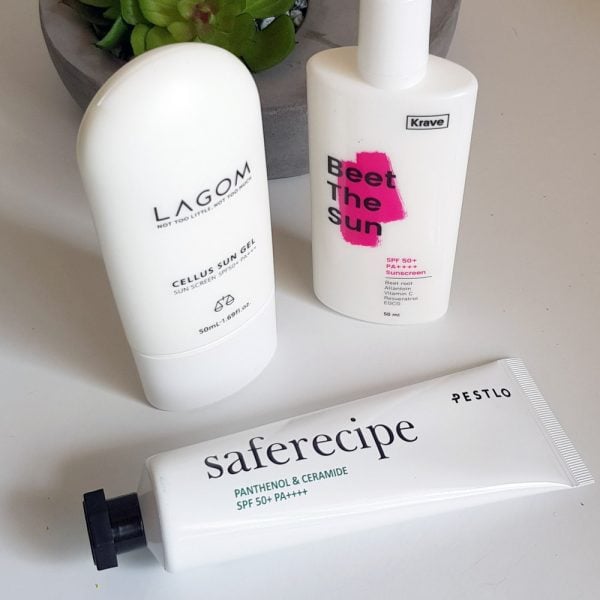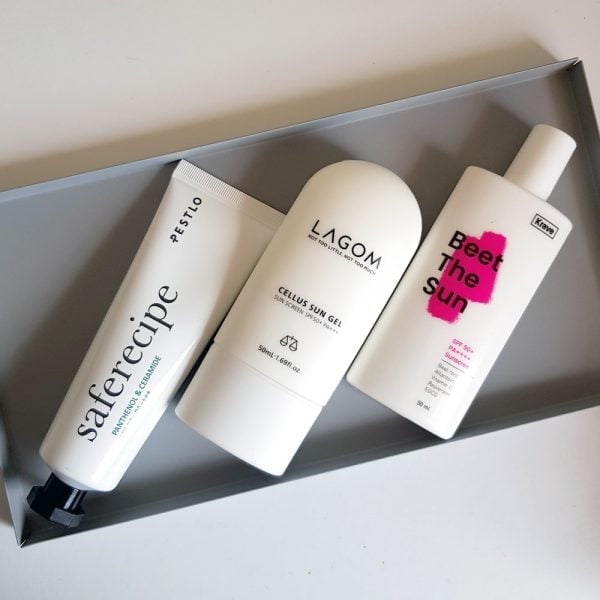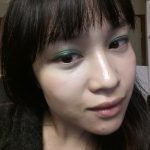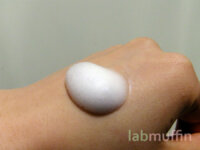I’ve tried out three more facial sunscreens lately, all of which originate from Korea. Asian sunscreens are known for their light textures and use of newer UVA filters, so I’ve reviewed quite a few of them before. (Note: Sunscreens aren’t approved in US/EU/UK/AU etc, but are approved in Korea.)

KraveBeauty Beet the Sun SPF 50+ PA++++
Beet the Sun ($20 USD for 50 mL, Amazon, KraveBeauty) is the first sunscreen from skincare YouTuber Liah Yoo’s KraveBeauty brand. I’ve reviewed their other products in the past, and I really enjoyed them, so I had high hopes for this sunscreen! It has a high SPF, and the exact UVAPF is a reasonable PPD 20 according to the company.
The sunscreen actives in Beet the Sun are all organic (chemical) filters: Uvinul A Plus, Tinosorb S, octyl triazone, amiloxate and polysilicone-15 (for a cheat sheet for the chemical names of common sunscreen actives, check out the free downloadable sample of my Skincare Guide).
Uvinul A Plus and Tinosorb S are newer photostable filters that give good UVA protection, especially against the longer UVA1 wavelengths. Traditional sunscreens tend to be a bit lacking in this region of the UV spectrum, hence the popularity of imported sunscreens in the US (luckily, they’re approved in Australia).
Related post: Why you should protect your skin from UVA (and how) (with video)
Tinosorb S is one of my favourite sunscreen ingredients – it’s photostable, so it doesn’t decompose over time, and it absorbs pigment-darkening UVA without giving a white cast. Beet the Sun has no white cast overall, and it’s fragrance-free as well (although it smells a little like sunscreen and alcohol).
The star plant extract here is beetroot extract, which has antioxidant properties. Free radicals are one of the ways that the sun causes skin damage and aging, and antioxidants are great at soaking up free radicals, although there haven’t been any studies on whether beetroot has this effect on skin (there are in vitro and dietary studies though).
I found that this sunscreen has a pretty oily texture that didn’t sink in too well into my skin, and stayed a bit greasy even after putting on make-up. It’s a particularly sweaty summer in Australia and I have oily skin, so I think it’ll work better if your skin is drier or you live somewhere less hot and humid.
The other your-mileage-may-vary issue I had is that it gave me a few clogged pores after a week of use, but almost all sunscreens do this to me – most people who’ve reviewed it didn’t have this problem.
I also don’t love Beet the Sun’s bottle cap. The rest of the packaging is great (squeezy bottle, skinny nozzle so you don’t squeeze out too much), but the cap’s thread is a bit hard to screw on correctly if you’re in a rush.
Beet the Sun isn’t available in the US yet due to its use of newer sunscreen filters. However, Krave Beauty do publicise that The Beet Shield, sold as an “antioxidant day fluid”, has the exact same formula but isn’t sold as a sunscreen. I have mixed feelings about the use of this strategy.
Water, Butyloctyl Salicylate, Dibutyl Adipate, Beta Vulgaris (Beet) Root Extract, Alcohol, Diethylamino Hydroxybenzoyl Hexyl Benzoate, Bis-Ethylhexyloxyphenol Methoxyphenyl Triazine, Ethylhexyl Triazone, Glycerin, Pentylene Glycol, Isoamyl p-Methoxycinnamate, Polysilicone-15, Inulin Lauryl Carbamate, Methyl Methacrylate Crosspolymer, Sodium Acrylate/Sodium Acryloyldimethyl Taurate Copolymer, Acrylates/C10-30 Alkyl Acrylate Crosspolymer, Tromethamine, Methylpropanediol, Isohexadecane, Caprylyl Glycol, Glyceryl Caprylate, Polymethylsilsesquioxane, 1,2-Hexanediol, Polysorbate 80, Lithospermum Erythrorhizon Root Extract, Macadamia Ternifolia Seed Oil, Sorbitan Oleate, Ethylhexylglycerin, Allantoin, Epigallocatechin Gallate, Sodium Ascorbyl Phosphate, Butylene Glycol, Resveratrol
Lagom Cellus Sun Gel SPF 50+ PA+++
Lagom Cellus Sun Gel ($27-46 USD / $39 AUD for 50 mL, Peach & Lily, Amazon, Franki and Seoul) is an organic (chemical) sunscreen. The sunscreen actives are octinoxate, octocrylene, octisalate, avobenzone and my favourite photostable UVA filter, Tinosorb S.
I really enjoyed using this sunscreen. The texture is very light and it sinks in easily – it feels more like a gel moisturiser than a sunscreen. Despite the high alcohol content, it also isn’t very drying. There’s no discernible white cast on me, and the scent is a mild herbal scent that might be lavender based.
Cellus Sun Gel comes in a squeezy bottle with a twist cap that’s easy to put back on and a narrow nozzle, although the bottle is a bit stiff so getting the last bits out may be an issue (it does stand with the nozzle pointing down though, so that might help).
The one thing I don’t like about this is, unsurprisingly, the low PA rating. According to Australian and EU standards, this wouldn’t count as a broad spectrum sunscreen. If high UVA protection is a priority for you, then this sunscreen isn’t ideal. Since I’m very hyperpigmentation-prone, this is unfortunately a deal-breaker for me.
Related post: My Routine for Fading Acne Marks (Post-Inflammatory Hyperpigmentation)
Water, Ethylhexyl Methoxycinnamate, Alcohol Denat., Octocrylene, Ethylhexyl Salicylate, Propanediol, Butyl Methoxydibenzoylmethane, Methyl Methacrylate Crosspolymer, Bis-Ethylhexyloxyphenol Methoxyphenyl Triazine, Methoxy PEG/PPG-25/4 Dimethicone, Bis-PEG/PPG-20/5 PEG/PPG-20/5 Dimethicone, Caprylic/Capric Triglyceride, Sodium Acrylate/Sodium Acryloyldimethyl Taurate Copolymer, Dimethicone, Isohexadecane, Acrylates/C10-30 Alkyl Acrylate Crosspolymer, Caprylyl Glycol, Citrus Aurantium Dulcis (Orange) Oil, Ethylhexylglycerin, Polysorbate 80,1,2-Hexanediol, BHT, Sodium Hydroxide, Lavandula Angustifolia (Lavender) Oil, Sorbitan Oleate, Disodium EDTA, Geranium Maculatum Oil, Citrus Aurantium Bergamia (Bergamot) Fruit Oil, Santalum Album (Sandalwood) Oil, Rose Flower Oil, Chamomilla Recutita (Matricaria) Flower Oil, Urea, Yeast Amino Acids, Trehalose, Betaine, Taurine, Inositol, Styrax Benzoin Gum, Commiphora Myrrha Oil, Phenoxyethanol, Potassium Sorbate.

Pestlo Safe Recipe Sun Essence SPF 50+ PA++++
Pestlo Safe Recipe Sun Essence ($21.40-34 USD / $37 AUD for 50 mL, Amazon, Franki & Seoul) is an inorganic (physical) sunscreen that uses a mixture of zinc oxide and titanium dioxide to achieve its UV protection level.
The base of this sunscreen is quite moisturising, and includes star ingredients panthenol at 10 000 ppm and ceramide NP at 1 ppm. There’s also centella extract, which is good for skin repair, and antioxidant chia seed extract.
Related post: Skincare Ingredient Spotlight: Centella Asiatica
Texture-wise, it’s very light for a physical sunscreen and lighter than most chemical sunscreens too. It has a pretty strong herbal scent, which goes away after a bit.
The problem for me with this sunscreen is that there’s some white cast, which always tends to be an issue with me with inorganic sunscreens. It’s especially bad when there’s titanium dioxide. While I could apply it more sparingly, it does mean a decrease in protection, and I don’t tend to wear heavy foundation. If your skin is lighter though, or you’re willing to wear thicker make-up, this won’t be an issue!
Water, Cyclomethicone, Zinc Oxide, Propanediol, Titanium Dioxide, Dicaprylyl Carbonate, Polyglyceryl-3 Polydimethylsiloxyethyl Dimethicone, Caprylyl Methicone, Cetyl Ethylhexanoate, 1,2-Hexanediol, Disteardimonium Hectorite, Magnesium Sulfate, Salvia Hispanica (Chia) Seed Extract, Centella Asiatica Extract, Houttuynia Cordata Extract, C30-45 Alkyl Cetearyl Dimethicone Crosspolymer, Hydrogen Dimethicone, Aluminium Hydroxide, Polyglyceryl-2 Dipolyhydroxystearate, Styrene/Acrylates Copolymer, Stearic Acid, Fructooligosaccharides (FOS), Saccharide Hydrolysate, Rosmarinus Officinalis (Rosemary) Leaf Extract, Pullulan, Pentylene Glycol, Ethylhexyglycerin, Octyldocecanol, Panthenol (10,000 ppm), Echium Plantagineum Seed Oil, Cardiospermum Halicacabum Flower/Leaf/Vine Extract, Helianthus Annuus (Sunflower) Seed Oil Unsaponifiables, Butylene Glycol, Dibutyl Adipate, Caprylic/Capric Triglyceride, Undecane, Tridecane, Tocopherol (Vitamin E), Phosphatidylcholine, Dimethicone Crosspolymer, Phenyl Trimethicone, Pinus Pinaster (Pine) Bark Extract, Ceramide NP (1 ppm), Glycine, Glutamic Acid, Serine, Lysine, Alanine, Arginine, Threonine, Proline, Helianthus Annuus (Sunflower) Seed Oil
More about picking a suitable sunscreen and how to use it with maximum benefit in your routine: The Lab Muffin Guide to Basic Skincare
These products were provided for editorial consideration, which did not affect my opinion. This post also contains affiliate links – if you decide to click through and support Lab Muffin financially, thank you! For more information, see Disclosure Policy.






Since you mentioned problems with clogged pores, I thought I’d share my current favorite sunscreen, which doesn’t give me any issues. I usually have the same problem. There are a dozen Japanese sunscreens I tried and I like this one best so far:
Kao Nivea Men UV Protector SPF50+ PA++++ (2018)
Ingredients:
http://www.cosdna.com/eng/cosmetic_7161353425.html
Info:
https://www.ratzillacosme.com/sun/nivea-men-uv-protector-spf50-4-plus/
Not sure if white cast would be an issue for you with this one because of the zinc oxide.
I’ll have to try it out, thanks for the rec!
I was actually relieved that Krave was able to find a loophole and officially sell to the US! Can I ask why you have mixed feelings about it? Do you think it’s inappropriate to exploit a loophole like that?
It’s technically illegal, so not really a loophole, which is why other sunscreen companies that sell newer filters overseas don’t do this. It’s the same strategy that brands advertising pseudoscience scam medical products use, and the main reason that the FDA don’t clamp down on this more is because they have limited resources.
I’m not entirely comfortable about a brand openly flouting the regulations this way. Drug regulation is incredibly important for consumer protection, and it isn’t like US consumers don’t have access to newer filters via the grey market, or that we would’ve have worked out that they’re the same product without them openly advertising it. And while the new sunscreen filters are products I love and think the FDA should allow, unlike scam pseudoscience products, I don’t think there should be different rules for products and brands I like and don’t like.
Thank you for bringing up this topic.
I am on my 3rd bottle of Beet the Sun. It is ok, but I tend to look a little greasy after the 2nd application when outside.
The pestlo sunscreen sounds great. I am super hyperpigmentation prone too so I always go for the highest PA rating. Anything to avoid melanogenesis. I have been hunting for a good sunscreen that would not sting my eyes which all of the chemical sunscreens I have tried have managed to do. Can’t get a mineral sunscreen since they all leave a white cast on my skin being a person of color. I am thinking of trying Anessa Whitening one, heard it has m-tranexamic in it. Have you ever tried any Anessa sunscreens?
I haven’t tried it myself, but my colleague uses Anessa and loves it!
If you get an opportunity (or a discount!) I’d love to see a review of Aesop’s new facial sunscreen – ive found that many of their products are worth the $$$ for a treat, even if I’d probably stick to my supermarket faves (currently cancer council facial matte) on a longer term basis
I’ll have to look for a sample! I have a friend who loves Aesop.
can you recommend any physical sunscreen which is not leaving a white cast? Thanks you!
I am using Make Prem blue ray sun gel. If you could review that that would be awesome. Also I live in Australia and am a cyclist so am in the sun a lot. I always wear 50+ broad spectrum sunscreen on my face, but to be prudent during summer I stop using acids like: glycolic, alpha-lipoic, lactic and retinols although I continue to use salicylic acid on my t-zone and azeliac more widely. Do you agree or do you think it’s fine to continue using stronger acids during summer as long as I use sunscreen. Thanks
Oh I use make Prem on my commute and days I am not doing a long ride. Otherwise then I use ultrasun 50+
I also wonder about the issue of acids in the Aussie summer (and vitamin C. And retinol) Things I’ve read seem to indicate that it’s okay as long as you’re good with the sunscreen, but since I started using actives I feel like my hyperpigmentation is actually getting worse, not better.
From what I’ve read (including from this blog) vitamin c (ascorbic acid) helps protect your skin from sun damage, and is often included in sunscreen formulas. It ought to be safe to use in the summer, especially under sunscreen. Some places recommend it.
Any kind of exfoliation will make your skin vulnerable to the sun, because it removes a layer of older skin and leaves the tender new skin exsposed. Some exfoliants have an additional sensitizing effect, but I think AHAs are the main culprit in that case. I’ve heard that BHAs, “PHAs” and retinol don’t have the additional effects.
Ultimately you need to decide how sensitive your skin is, but I hope this helps.
Thanks Ilia! That was my understanding too, but it was only after starting with vitamin C that I developed some big dark sun splotches (for want of a better word) so I guess I’ve been questioning what’s going on for my skin. I’ve been thinking that perhaps the use of actives has just coincided with long-term sun damage showing up on the surface (despite always being pretty good with care, this fair-skinned blonde has had 35 years of Aussie sunshine to contend with) so my skin is worse than it used to be, but better than it would have been without skin care. That’s the problem with not having a control group for your own face!
Couldn’t have said it better myself 🙂
Thanks for the replies ! I will persist with the Vitamin C and ease off on the glycolic acid, and save the salicylic for controlling breakouts. And MORE sunscreen 🙂
Too bad, I had high hopes for the second one, but as hyperpigmentation is my main issue, I will look for something with a higher UVA protection.
Anne|Linda, Libra, Loca
Would love to hear more of your thoughts about Krave’s sunscreen loophole in the U.S.! It initially struck me as sneaky-smart (and I was happy because I’m in the U.S.) but I’m curious about why you have mixed feelings.
The Krave beauty is available in the US it just has a different name. The Beet Shield… it is the same as Beet the Sun but in order to get it to the US they had to change the label. They explain it in there blog. I just wanted to give you a heads up
Hi Michelle,
In your review of the Beet Shield you wrote that you have mixed feelings about Krave beauty using a loophole and marketing this product as an “antioxidant day fluid” in the US where it can’t be sold as a sunscreen. Could you please explain where your mixed feelings stem from? Also why can’t the Beet Shield be sold in the US as a sunscreen? Why won’t the FDA approve these new UVA filters? Has there not been enough research on them or is the FDA aware of some kind of side affects?
Thanks,
Quinn
Please please please review hada labo’s uv sunscreen.
I’ll have to look out for it!
Hey Michelle,
I am brand new here, but are these reef-safe? Would you have recommendations for sunscreens that are?
Sunscreen and coral reef damage is a complex topic – I have a post (and video) on it here: Is Your Sunscreen Killing Coral? The Science (with Video)
PLEASEEE review hada labo’s uv white gel <3